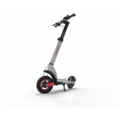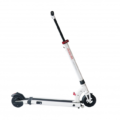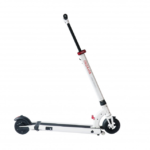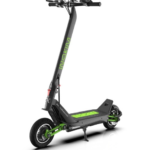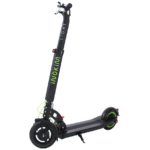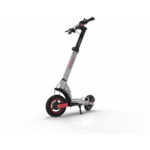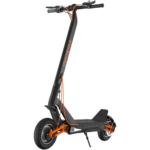- Home
- Scooters
- Electric Scooters
- INOKIM Quick 3
INOKIM Quick 3



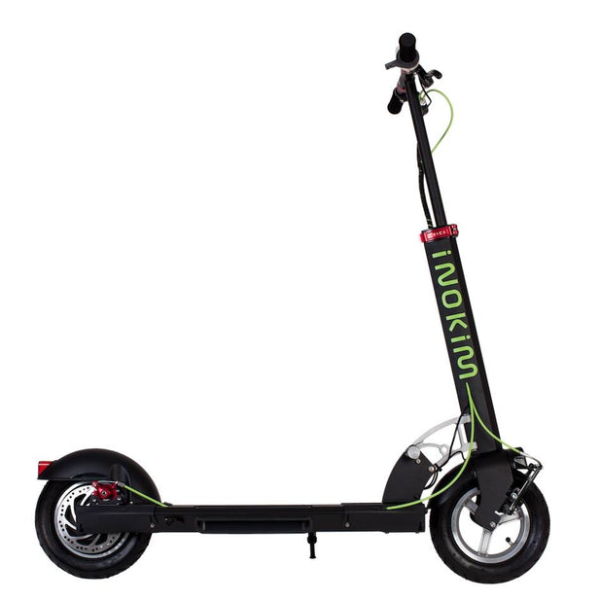
- Battery Range: 20–25 miles (32–40 km)
- Top Speed: 19 mph (30 km/h)
- Motor Power: 450 W
- Weight Capacity: 265 lb (120 kg)
- Charging Time: ≈6–7 h
- Scooter Weight: 36.4 lb (16.5 kg)
PROS
- 10″ pneumatic tires
- Front V-brake + rear disc
- Adjustable stem and folding bars
- Clear LCD with speed/battery
- IPX4 splash resistance
CONS
- No suspension
- Moderate top speed
- Limited smart/app features
Key Takeaways
- The INOKIM Quick 3 is a commuter scooter designed for steady daily rides with good performance.
- It comes in two trims, Hero and Super, each varying in battery capacity for different riding needs.
- This scooter features a durable aluminum frame, 10-inch tires, and effective braking systems for reliable control.
- With a low center of gravity, the Quick 3 offers a comfortable ride and easy handling in urban environments.
- It’s ideal for city commuting but less suitable for long suburban trips or steep hills.
Table of contents
- What Is the INOKIM Quick 3?
- How the INOKIM Quick 3 Works
- Key Specifications
- Design & Build Quality
- Performance Fundamentals
- Battery, Range & Efficiency
- Ride Quality & Comfort
- Braking & Safety Features
- Portability & Daily Usability
- Maintenance & Care
- Weather & Seasonal Considerations
- INOKIM Quick 3 vs Alternatives
- Who the INOKIM Quick 3 Is (and Isn’t) For
- FAQs
- Glossary
- Maintenance Checklist (One-Page Summary)
- Riding Tips for Best Results
The INOKIM Quick 3 is a city scooter that puts day-to-day riding first. It feels steady, folds fast, and holds up to real use. If you want a calm commute without drama, this one fits. And if you care about official specifications more than hype, you will appreciate the details.
What Is the INOKIM Quick 3?
The Quick 3 sits in the middle of the commuter range. It uses a tough aluminum frame, 10-inch air-filled tires, and dual mechanical brakes. The stance feels planted, and the fold latch clicks with a clean, secure feel. Cables hug the stem, so nothing snags on jackets or bags.
Two trims are common. Hero runs a 48 V, 10.4 Ah battery for normal days. Super bumps capacity to 48 V, 13 Ah for longer rides. Both share the same frame, tires, and cockpit. So you just pick the range you need and keep the same ride feel.
INOKIM leans into durability. The deck is long and grippy. The stem stays tight at city speeds. Screws seat flush and stop creaks when you keep them snug. And the split braking setup gives smooth control in dry or damp weather. So stops feel predictable in traffic. If you want more power and a roomier platform, take a look at the INOKIM Quick 4 as a step up.
How the INOKIM Quick 3 Works
Think of the system as a simple loop. You press the thumb throttle. The controller meters current. Then the rear hub turns that into forward motion. The LCD shows speed, mode, and battery level so you can pace the ride.
Motor and controller. The rear hub is about 450 W nominal. Power ramps in smooth, so starts feel calm. The single rear motor keeps traction tidy on clean pavement. For city riding, that balance helps more than raw punch.
Battery. The pack sits in the deck for a low center of gravity. Hero holds 48 V, 10.4 Ah (about 499 Wh). Super holds 48 V, 13 Ah (about 624 Wh). So Super adds useful headroom for longer loops. A 54.6 V, 2 A charger tops either pack at a steady rate.
Throttle. A right-hand thumb lever controls speed. The LCD shows what you need at a glance. Cruise control can hold pace on long paths. It shuts off the moment you touch a brake.
Brakes. The Quick 3 pairs a front drum with a rear rim caliper. The drum keeps working in wet or dusty conditions. The rear caliper adds fine control at low speed. So lever feel is smooth, and bite builds as you pull.
Key Specifications
Values reflect common trims. Local speed limits can apply.
| Block | Item | Value |
|---|---|---|
| General | Model | INOKIM Quick 3 (Hero / Super) |
| Frame | 6061-T6 aluminum alloy | |
| Tires | 10 × 2.5 in pneumatic, front and rear | |
| Max rider load | 265 lb (120 kg) | |
| Top speed* | Up to 20 mph (32 km/h) where allowed; many regions cap to 15.5 mph (25 km/h) | |
| Performance & Power | Motor | Rear hub, ~450 W nominal |
| Drive | Single motor, rear-wheel | |
| Hill behavior | Handles short 7–10% grades with pacing | |
| Battery, Charging & Electrical | Battery (Hero) | 48 V, 10.4 Ah, ~499 Wh |
| Battery (Super) | 48 V, 13 Ah, ~624 Wh | |
| Charger | 54.6 V, 2 A | |
| Charge time | ~6–7 h (Hero), ~7–9 h (Super) | |
| Display | LCD throttle unit with speed, mode, trip, odometer | |
| Build & Dimensions | Unfolded | ~43 × 24 × 45 in (109 × 61 × 114 cm) |
| Folded | ~43 × 10 × 15 in (109 × 25 × 38 cm) | |
| Weight (Hero) | ~36–37 lb (16.5–16.8 kg) | |
| Weight (Super) | ~38–39 lb (17.2–17.8 kg) | |
| Deck | Long platform with full griptape | |
| Safety & Control | Brakes | Front drum + rear rim caliper (mechanical), motor cut on lever pull |
| Lights | Front LED, rear LED with brake function | |
| Water protection | Light splash resistance; no formal IP code listed | |
| Features & Extras | Ride modes | Multiple speed modes |
| Cruise control | Yes | |
| Kickstand | Yes | |
| Bell | Yes | |
| Warranty & Compliance | Warranty | Commonly 12 months on major parts; region rules vary |
| Compliance | Local rules on speed and road use vary by city and country |
* Obey local rules at all times.
Design & Build Quality
This scooter feels solid from the first grab. The frame uses thick aluminum sections with neat welds. Paint coverage looks even. And the folding joint latches with a clear snap that builds trust. So the stem sits straight after many fold cycles.
The cockpit is tidy and practical. The LCD throttle lives on the right. Levers fall under your fingers without stretch. Grips use a firm compound with a texture that works in heat and cool mornings. Cables run close to the stem to avoid snags.
The deck helps a lot with comfort. It is long and wide enough for a split stance. Griptape reaches the edges so shoes stay planted over bumps. Then the kickstand drops with a light tap and tucks in close. Quick stops at a shop feel simple.
Fit and finish sit above the mass-market crowd. Screws match and seat flush. Hubs spin true when tires are at the right pressure. And the stem clamp stays quiet if you keep it clean and tight. Over months, that solidity saves time.
Performance Fundamentals
City starts show the mapping. The Quick 3 eases off the line without a jerk. Throttle response is linear, so crosswalks feel steady. And rear-wheel drive keeps the front planted over cracks as you roll.
Cruising is calm. The long wheelbase and 10-inch tires help the scooter track straight. Small seams and joints turn into a muted thump. So your hands relax, and focus stays on traffic.
Hills take some pacing. On short 7–10% grades, it climbs if you carry a little speed at the base. For example, enter at a steady pace, keep knees soft, and hold the throttle. Speed dips a bit, yet the scooter keeps pulling. On long, steep climbs, plan gentler streets instead of trying to brute-force up.
Battery, Range & Efficiency
Range moves with speed, mass, hills, wind, and temperature. Hero fits most urban days with margin. Super adds clear buffer for longer loops or winter. Both packs hold voltage well through the top half of the gauge.
Warm weather helps. Cells give up energy more easily. Rolling losses drop once you reach cruise. So watt-hours per mile look better in summer. In fact, you will likely see a gap in winter when cold cells sag and headwinds add drag.
Charging is simple. Plug the 54.6 V charger into the deck port. Let the fan run and keep the brick on a hard surface. Then unplug when the light turns green. For long life, avoid running the pack to empty. Store near mid-charge if you take a week off.
Small habits stretch range. Hold tires in the 35–45 psi window that fits your weight. Coast early toward red lights. And pick a lower mode on crowded paths where high speed gains nothing. These steps save energy without slowing your real trip.
Ride Quality & Comfort
Comfort starts with tires and geometry. The Quick 3 runs 10-inch pneumatic tires that soak up chatter. So brick lanes and rough edges fade before they reach your hands. The deck gives space to stagger your feet for balance and shock absorption.
Steering stays stable. At legal city speeds the bar holds a straight line with light input. Stem flex feels low, so corrections land right where you want. For example, when you dodge a pothole, the scooter carves a clean arc, not a wobble.
Road quality still matters. On broken pavement, slow down and pick the smoothest line you can see. Then let the tires and your knees do the rest. The chassis avoids complex linkages, so it stays quiet over time. Service stays simple too.
Braking & Safety Features
The braking package favors control and consistency. The front drum gives baseline power that resists water and dust. The rear rim caliper adds fine modulation for tight spaces. So you can adjust the stop by shifting pressure between levers.
Lighting covers both ends. A forward LED improves your presence at dusk. A rear LED brightens under braking so drivers notice sooner. For example, add reflective tape to a helmet or pack to boost contrast at night. Then drivers pick you out earlier.
Wet rides need patience. The Quick 3 handles light splash but lists no formal IP code. So ride slower in rain and avoid standing water. Dry the scooter after the trip. Clear grit from pads so bite stays strong and noise stays low.
Portability & Daily Usability
Daily use comes down to fold speed, size, and weight. The Quick 3 folds with a simple lever and a catch near the deck. So you can drop the stem, lock it, and lift in seconds. Hero weighs about 36–37 lb (16.5–16.8 kg). Super adds about 1–2 lb (0.5–1 kg). For stairs and short hops, that is manageable with a firm grip.
Transit and storage want a slim shape. The folded scooter stays long and narrow. It rests against your leg on a train without blocking aisles. Bar ends sit close, which reduces snags. And the kickstand holds it upright in narrow halls.
Security follows common sense. Bring it indoors when you can. If you must lock outside, wrap a sturdy U-lock around the deck structure and a cable through a wheel. Then take any quick-release bits with you. That habit saves parts and time.
Maintenance & Care
A short routine keeps the Quick 3 in shape. Then a simple schedule helps you stay consistent:
- Before every ride: Check tire pressure. Spin wheels and listen for rub. Tap the fold latch and confirm the catch is tight.
- Weekly: Wipe the frame and stem. Check fasteners with the right hex keys. Inspect cable tension and pad wear.
- Monthly: True wheels if you see side-to-side wobble. Clean the rear rim if your unit uses rim pads. Add a drop of light oil to brake cables.
- Every 3–6 months: Check headset play by holding the front brake and rocking. Tighten the top nut if you feel knock. Inspect the kickstand mount and the charger port fit.
Battery care matters. Store near mid-charge if you pause for more than a week. Keep the pack at room temperature. Let it cool to room temp before charging after hot rides. These habits support capacity over time.
Weather & Seasonal Considerations
Rain changes grip and braking distance. Slow down and leave more space. Then pre-dry the rear rim with a gentle squeeze before a full stop. The front drum keeps working through spray, yet paint lines and metal covers get slick.
Heat affects tires and batteries. On very hot days, park in the shade. Check pressure after rides since heat raises PSI. Let the pack cool before you plug in. That pause reduces stress on cells.
Cold cuts range. Cells give less energy at low temps. Plan shorter routes in winter. Start indoors so the pack warms a bit. Then keep throttle inputs smooth. Hard pulls waste energy when cells are cold.
INOKIM Quick 3 vs Alternatives
Commuter scooters break into three groups. Light last-mile models, mid-power daily riders, and heavy high-speed machines. The INOKIM Quick 3 lives in the middle, and that slot fits most city days.
Against light last-mile scooters, the Quick 3 brings bigger tires, stronger brakes, and a stiffer frame. So it tracks straighter, stops shorter, and carries more load. It does weigh more. If weight matters most, the INOKIM Light 2 keeps things compact and easy to carry.
Against heavy high-speed machines, the Quick 3 wins on fold speed and upkeep. It fits in trunks, goes upstairs, and eats fewer wear parts. It will not match the rush or range of dual-motor giants. Overall, pick the Quick 3 if you want a calm, capable daily ride and a compact fold.
Who the INOKIM Quick 3 Is (and Isn’t) For
Great for:
- Daily city commutes at legal speeds.
- Students and office workers who store indoors.
- Multi-modal riders who mix train, bus, and scooter.
- New riders who want smooth power and clear controls.
- Owners who prefer quiet parts and low fuss.
Less ideal for:
- Long suburban trips on fast roads.
- Routes with frequent, very steep hills.
- Riders above the weight limit.
- Off-road use on loose or muddy surfaces.
Pick Hero if your routes are short to medium. Pick Super if you ride longer loops or through colder seasons. Then set tire pressure, learn your route, and keep a light touch on the controls.
FAQs
Does the INOKIM Quick 3 have cruise control?
Yes. It holds speed on long paths until you touch a brake or the throttle.
What is the real-world range?
Range moves with speed, rider mass, hills, wind, and temperature. Hero covers typical city days. Super adds clear buffer for longer rides. In winter, plan extra margin.
How fast can it go?
Where rules allow, you can reach about 20 mph (32 km/h). Many regions cap speed to 15.5 mph (25 km/h). So follow local limits.
What tires does it use, and what pressure works best?
It runs 10-inch pneumatic tires. Start at 35–45 psi based on weight. Then adjust a few psi for comfort or grip.
What brakes come on the Quick 3, and how do they feel?
It has a front drum and a rear rim caliper. Lever feel is smooth, and power builds as you pull. Low-speed stops feel easy to modulate.
Can I ride it in the rain?
Light rain happens, and the scooter handles splash. Still, avoid deep puddles and slow down. Then dry the scooter after the ride.
What is included in this INOKIM Quick 3 overview, and where can I see the specifications?
This INOKIM Quick 3 overview gives core facts, ride behavior, care tips, and a clean table of key data. The table above lists the specifications in one place.
Glossary
Ah (amp-hours): A measure of stored charge in a battery. Higher Ah means more capacity at a fixed voltage.
Wh (watt-hours): Voltage times amp-hours. It estimates total energy in a pack.
Controller: The unit that meters current from the battery to the motor.
Hub motor: A motor built into the wheel hub. It saves space and needs little service.
Rim brake: A caliper that squeezes the wheel rim with pads.
Drum brake: A brake with shoes inside a drum that create friction.
Regen: A system that sends energy back to the battery during braking. The Quick 3 relies on mechanical braking instead.
Stem flex: Movement in the handlebar post under load. Less flex gives a more direct feel.
IP rating: A code for dust and water resistance. The Quick 3 lists no formal code.
Cruise control: A feature that holds a set speed until you brake or touch the throttle.
Grade: The steepness of a hill shown as a percentage.
Payload: The maximum weight the scooter supports, including rider and gear.
PSI: Pounds per square inch. A tire pressure unit.
Wheelbase: The distance between the centers of the front and rear wheels.
Voltage (V): Electric potential that, with current, defines power.
Watt-hours per mile: An energy-use figure that helps compare efficiency.
Maintenance Checklist (One-Page Summary)
- Before rides: Tire pressure, latch tightness, wheel rub check.
- Weekly: Wipe frame and stem, check pad wear, snug key fasteners.
- Monthly: True wheels, clean rear rim if used, lube cables.
- Seasonal: Check headset play, inspect kickstand mount, inspect charger and port.
- Battery care: Avoid full drains, store near mid-charge, keep at room temp.
Riding Tips for Best Results
- Start in a lower mode until you know the route.
- Keep knees soft and eyes up over rough patches.
- Use both brakes and press down on the deck in hard stops.
- Slow for wet paint lines and metal covers.
- Charge after rides once the pack is cool.
Specifications
General
| Model The Model specifies the exact version or name of the scooter. It helps identify its unique design, features, and specifications within the manufacturer’s product line. Knowing the model makes it easier to compare options, find compatible accessories, or look up support information. | Quick 3 |
| Brand The Brand identifies the manufacturer or company that designs and produces the scooter. A trusted brand is a sign of quality, reliability, and good customer support. Well-known brands often have higher standards for safety, performance, and after-sales service, giving you more confidence in your purchase. | INOKIM |
| Release Date The Release Date indicates when the scooter model was officially launched on the market. This helps you know how current the design, technology, and features are. A newer release date often means updated components, improved performance, and the latest safety or smart features. | 18 November 2025 |
| Recommended Age Recommended Age indicates the minimum age range that the scooter is designed for, based on safety, size, and ease of use. Following the recommended age helps ensure that riders can handle the scooter’s speed, weight, and controls comfortably and safely. Always check local laws and use protective gear, especially for younger riders. | +16 |
Performance & Power
| Motor Power (Wattage) What it means: The motor power, measured in watts (W), shows how strong the scooter’s electric motor is. Why it matters: Higher wattage usually means better acceleration, more torque, and improved performance on hills or rough terrain. For example, a 250W motor is good for flat city roads and light riders, while a 500W or 1000W motor provides more power for faster speeds or climbing steep inclines. | 450 W rear hub |
| Top Speed The Top Speed indicates the maximum speed that the scooter can reach under optimal conditions. It’s usually measured on level ground with a fully charged battery and an average rider weight. A higher top speed allows you to travel longer distances faster, but always ensure you ride within legal speed limits and your personal comfort zone for safety. | 19 mph (30 km/h) |
| Battery Capacity Battery Capacity refers to the total amount of energy the scooter’s battery can store, usually measured in ampere-hours (Ah) or watt-hours (Wh). A higher battery capacity means you can ride longer distances on a single charge, reducing the need for frequent recharging. Keep in mind that actual range can vary depending on rider weight, terrain, speed, and weather conditions. | Not specified |
| Estimated Range per Charge The Estimated Range per Charge indicates the average distance the scooter can travel on a single full battery charge. This range is calculated under optimal conditions, such as flat terrain, moderate speed, and average rider weight. Real-world range may vary depending on riding style, terrain, weather, and load. A longer range means fewer recharges and greater freedom for longer trips. | 20–25 miles (32–40 km) |
| Hill Climb Ability Hill Climb Ability describes the maximum incline or slope that the scooter can handle while maintaining stable performance. It’s typically expressed as a percentage or in degrees. A higher hill climb rating means the scooter can tackle steeper hills without losing too much speed or power. Actual climbing performance may vary based on rider weight, battery charge, and terrain conditions. | Not specified |
| Drive System The Drive System refers to how power from the motor is delivered to the wheels. Electric scooters typically use either a hub motor (directly integrated into the wheel) or a chain/belt drive system. A high-quality drive system ensures smooth acceleration, efficient power transfer, and low maintenance. The choice of drive system affects performance, noise level, and overall ride experience. | Rear hub (RWD) |
Charging & Electrical
| Charging Time Charging Time indicates how long it takes to fully recharge the scooter’s battery from empty to 100% using the standard charger provided. Faster charging means less downtime and more time on the road. Actual charging time may vary slightly depending on battery capacity, charger output, and environmental conditions. | Approx. 6–7 hours |
| Battery Type Battery Type refers to the specific technology used in the scooter’s battery, which affects performance, lifespan, weight, and charging time. Most modern electric scooters use high-quality lithium-ion (Li-ion) batteries because they offer a good balance of energy density, durability, and low maintenance. A reliable battery type ensures consistent power delivery and longer riding ranges. | Lithium-ion (BMS) |
| Removable Battery A Removable Battery means the battery pack can be easily detached from the scooter for convenient charging and replacement. This feature allows you to charge the battery separately, swap it with a spare for extended range, or securely store it indoors in extreme weather. Removable batteries add flexibility and make it easier to keep your scooter powered up wherever you are. | No |
| Regenerative Braking Regenerative Braking is an energy-saving feature that converts some of the energy normally lost during braking back into battery power. When you slow down or brake, the motor works in reverse to generate electricity, which helps extend the scooter’s range and improves overall efficiency. This system also reduces wear on traditional brake components, leading to lower maintenance over time. | Regenerative braking: Not specified |
| Lighting Lighting refers to the built-in front and rear lights that enhance visibility and safety when riding in low-light conditions or at night. Good lighting helps you see the road ahead and ensures that other road users can see you. Many scooters include LED headlights, taillights, and sometimes brake lights or side reflectors for added safety and compliance with local traffic regulations. | LED headlight + rear LED |
Build & Dimensions
| Scooter Weight Scooter Weight refers to the total weight of the scooter when fully assembled, including the battery. This affects how easy it is to carry, lift, and store the scooter when not in use. A lighter scooter is more portable and convenient for commuting, especially if you need to carry it upstairs or onto public transport. Keep in mind that a sturdy frame and quality components may add to the weight but also contribute to better durability and ride stability. | 36.4 lb (16.5 kg) |
| Maximum Rider Weight Maximum Rider Weight indicates the highest rider weight that the scooter is designed to safely support while maintaining optimal performance and stability. Staying within this limit helps ensure reliable acceleration, braking, and climbing ability, and it protects the frame, suspension, and motor from excessive strain. Exceeding the recommended limit may reduce performance and increase wear on components. | 265 lb (120 kg) |
| Deck Size Deck Size refers to the dimensions of the scooter’s standing platform. A wider and longer deck provides more foot space, allowing you to stand comfortably and adjust your stance while riding. A well-sized deck improves balance and stability, especially on longer rides or at higher speeds. Compact decks, on the other hand, help keep the scooter lightweight and portable. | Wide deck with integrated carry handle |
| Handlebar Height Handlebar Height refers to the distance from the deck to the handlebars, which affects your riding posture and comfort. An appropriate handlebar height helps you maintain good balance, reduces strain on your back and arms, and makes steering more comfortable. Some scooters have adjustable handlebars to fit riders of different heights, while others have a fixed height for a streamlined design. | Adjustable (telescopic) |
| Folding Mechanism The Folding Mechanism describes how easily and securely the scooter can be folded for carrying and storage. A well-designed folding system lets you quickly collapse the scooter into a compact size, making it convenient to transport on public transit, store under a desk, or fit into a car trunk. Look for sturdy latches and safety locks to ensure the scooter stays firmly in place when folded or unfolded. | Quick-fold stem + folding handlebars |
| Dimensions Folded Dimensions indicate the size of the scooter when it’s fully folded. This measurement shows how much space the scooter will take up when stored or carried, making it easier to check if it will fit in your car trunk, under a desk, or in a closet. Compact folded dimensions are ideal for commuters who need to bring their scooter on public transport or store it in tight spaces. | Folded: Not specified; Unfolded: Not specified |
| Material Material refers to the primary construction materials used for the scooter’s frame and key components. High-quality materials like aircraft-grade aluminum, reinforced steel, or durable composites provide strength, stability, and a lighter overall weight. A sturdy material ensures the scooter can handle daily wear and tear while maintaining safety and performance. | Aluminum alloy |
Safety & Control
| Brake Type(s) Brake Type(s) describe the braking systems the scooter uses to help you slow down or stop safely. Common brake types include mechanical brakes (like drum or disc brakes), electronic brakes, and foot brakes. Many scooters combine multiple braking systems for added safety and shorter stopping distances. The type and quality of brakes affect your control, especially when riding at higher speeds or on slopes. | Front V-brake + rear disc |
| Suspension Suspension refers to the system that absorbs shocks and vibrations while riding, providing a smoother and more comfortable ride over uneven or rough surfaces. Scooters may have front suspension, rear suspension, or dual suspension for better shock absorption and stability. Good suspension helps reduce rider fatigue and improves control, especially when riding on bumpy roads or off-road paths. | None |
| Tire Type Tire Type refers to the kind of tires the scooter uses, which directly affects ride comfort, traction, and maintenance. Common types include solid (airless) tires, pneumatic (air-filled) tires, or hybrid options. Pneumatic tires offer better shock absorption and a smoother ride on rough surfaces, while solid tires are puncture-proof and require less upkeep. The right tire type helps ensure safe handling and a comfortable ride in different conditions. | 10″ × 2.5″ pneumatic (F/R) |
| Tire Size Tire Size indicates the diameter and width of the scooter’s tires, which affect ride comfort, stability, and how well the scooter handles different terrains. Larger tires generally offer better shock absorption and a smoother ride over bumps and rough surfaces, while smaller tires keep the scooter lighter and more portable. Choosing the right tire size helps ensure a balance between agility and comfort. | 10-inch |
| Kickstand The Kickstand is a built-in stand that allows you to park your scooter upright when it’s not in use. A sturdy kickstand keeps the scooter stable and prevents it from tipping over, protecting it from scratches and damage. It also makes storing and accessing your scooter more convenient, whether you’re at home, work, or on the go. | Side kickstand |
| Water Resistance Rating Water Resistance Rating indicates how well the scooter is protected against water and moisture, usually shown as an IP (Ingress Protection) rating. This rating helps you understand whether the scooter can handle light rain, splashes, or wet roads without damage. While most scooters are not fully waterproof, a good water resistance rating adds peace of mind when riding in changing weather conditions. Always avoid deep puddles or submerging the scooter to protect its electrical components. | IPX4 |
Features & Extras
| Display/Console The Display (or Console) shows important real-time information about your ride, helping you monitor your scooter’s status at a glance. Typical displays show speed, battery level, distance traveled, and riding mode. Some models also include additional features like Bluetooth connectivity, app integration, or backlighting for better visibility at night. A clear and easy-to-read display enhances safety and convenience on every trip. | LCD with speed, battery, odometer; thumb throttle |
| Ride Modes Ride Modes refer to the different speed and power settings you can choose to match your riding style or road conditions. Common modes include eco for maximum range and energy efficiency, standard for everyday balance, and sport or turbo for higher speed and stronger acceleration. Switching between ride modes allows you to customize performance, conserve battery, and ride safely in various environments. | 3 modes (Eco/Drive/Sport) |
| Smart App Connectivity Smart App Connectivity lets you pair your scooter with a dedicated mobile app via Bluetooth. Using the app, you can monitor real-time ride stats like speed, battery level, and range, adjust settings such as ride modes or cruise control, lock the scooter for added security, and sometimes receive firmware updates. This feature adds convenience and allows you to personalize your riding experience right from your smartphone. | No dedicated app (availability varies by region) |
| Anti-Theft System The Anti-Theft System helps protect your scooter from unauthorized use or theft. This feature can include built-in alarms, electronic motor locks, GPS tracking, or remote locking through a mobile app. A good anti-theft system provides peace of mind when parking your scooter in public spaces, adding an extra layer of security to safeguard your investment. | None |
| Cruise Control Cruise Control allows you to maintain a steady speed without continuously holding the throttle. This feature makes longer rides more comfortable by reducing hand fatigue and providing a smoother, more relaxed riding experience — especially on flat, open roads or bike lanes. For safety, cruise control can usually be easily activated or deactivated while riding. | Yes (controller setting; may vary) |
| Accessories Included Accessories Included lists the additional items that come with the scooter to enhance your riding experience and convenience. Common accessories may include a charger, kickstand, bell, lights, phone holder, or carrying strap. These extras add value by making your scooter safer, easier to use, and ready to ride straight out of the box. | Scooter, charger (≈42 V 2 A), tools, manual |
Warranty & Compliance
| Warranty Period The Warranty Period indicates how long the manufacturer guarantees the scooter against defects in materials and workmanship under normal use. A good warranty provides peace of mind, showing the brand’s confidence in its product quality. Always check what parts are covered, such as the frame, battery, and motor, and follow the maintenance guidelines to keep your warranty valid. | 12 months (region-dependent) |
| Certifications Certifications confirm that the scooter meets specific safety, quality, and environmental standards set by recognized organizations or regulatory bodies. Common certifications may include CE, RoHS, UL, or other local compliance marks, depending on your region. These certifications ensure that the scooter is manufactured to high standards and is safe and legal to use in your country. | Region-dependent |


